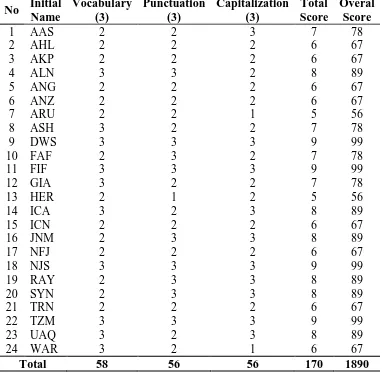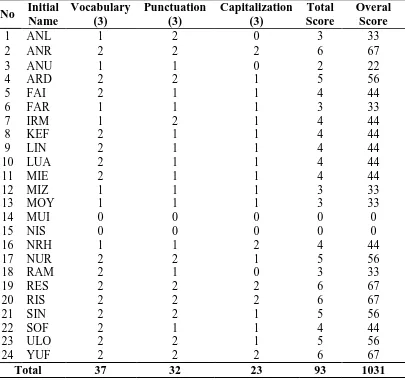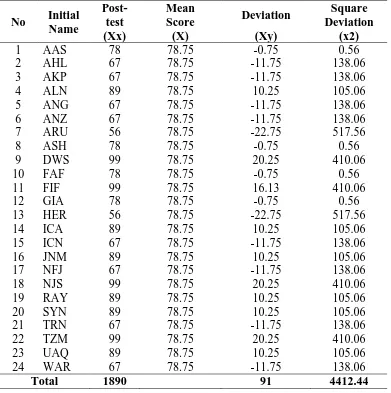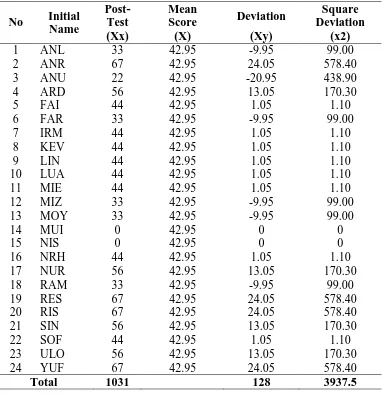e-Journal of English Language Teaching Society (ELTS) Vol. 4 No. 1 2016 – ISSN 2331-1841 Page 1
IMPROVING WRITING ABILITY OF
GRADE VII STUDENTS THROUGH
CLUSTERING TECHNIQUE
Ika Rizka Dzulhijjah1, Ferry Rita2, Hastini3
Abstract
The objective of this research was to find out whether or not the use of clustering technique improved writing ability of grade VII students at SMP Negeri 1 Sindue in writing descriptive text. This research was an intact group research design that involved two groups; they were experimental group and control group. The population of this research was grade VII students of SMP Negeri 1 Sindue. It was selected by using purposive sampling technique. The sample was VII B as the experimental group and class VII C as the control group. In collecting the data, the researcher used test (post-test). The data were analyzed statistically. The results of data analysis showed that there was a significant difference between the achievement of experimental and control groups. In other words, the t-counted (9.22) was greater than t-table (2.015). In this case, the research hypothesis was accepted. In short, the use of clustering technique can improve writing ability of grade VII students’ at SMP Negeri 1 Sindue in writing mechanics and vocabulary.
Keywords: Improving; Writing Ability; Clustering Technique.
INTRODUCTION
In Indonesia, English has been taught to the students of Elementary Schools (SD),
Junior High Schools (SMP), Senior High Schools (SMA), and Universities. It is expected
that by learning English, they will be able to communicate in English with International
communities.
The most important thing in human being life is communication. By using language
communication among human being can be done. Language is an important part in human
social life. As a tool of communication, language is conveyed through four skills. There are
listening, speaking, reading, and writing. To maintain the four skills, English learners also
learn the language components such as grammar, vocabulary, mechanics and pronunciation.
The aim of teaching English to the students is to improve their English ability. The
students are expected to be able to communicate both in oral and written forms. Anyhow,
e-Journal of English Language Teaching Society (ELTS) Vol. 4 No. 1 2016 – ISSN 2331-1841 Page 2 According to the researcher’s preliminary research at SMP Negeri 1 Sindue, the
grade VII students still have problems in learning English, particularly in writing. There
were several problems that students faced in their writing, such as they cannot express their
ideas easily in written form because they did not have enough vocabulary. Besides, they did
not know how to use mechanics as well, like punctuation and capitalization. By looking at
the situation, the researcher restricted her research in vocabulary, punctuation, and
capitalization.
To solve these problems, the researcher used clustering technique. The application
of clustering technique can helps the students to find out the ideas as many as possible. Rico
(2001:1) explains, ”Clustering technique is a technique for quickly making explicit the idea
and associations we have about the topic”. Therefore, teaching descriptive text using
clustering technique is appropriate to use. according to DePorter and Hernacki that was
cited in Hermansyah thesis (1999:181) emphasize that clustering is the way to classify the
ideas and share into a piece of paper by making the connection with the core of the idea.
Clustering is powerful tool in freewriting to generate the ideas from mind. This technique is
simple to be applied by the students. It means that, they were easy to find a word as a
keyword related with the topic.
The researcher used clustering technique in order to make the students easier to get
their idea in writing. Therefore, the researcher expected that by applying this technique the
students are more creative in making sentences, particularly in descriptive text. A
descriptive text is one types of the texts which is fun to write. It makes students’ writing
more interesting to readers because they use their words to help readers see, or to visualize
people, places, or things.
The subject of this research was grade VII students at SMP Negeri1 Sindue.
Considering that problem, the researcher formulated the research question as follows: “Can
the writing ability ofgrade VII students at SMP Negeri 1 Sindue be improved through
clustering technique?”. The objective of this research was to improve the students’writing ability of grade VII students at SMP Negeri 1 Sindue through clustering technique.
METHODOLOGY
In this research, the researcher applied intact group design. Intact group design is a
part of pre experimental research. In intact group design, the researcher used two groups
e-Journal of English Language Teaching Society (ELTS) Vol. 4 No. 1 2016 – ISSN 2331-1841 Page 3 test which only post-test while the treatment was given only for experimental group.The
design of this research proposed by Hatch and Farhady (1982: 21) as follows:
G1 X T2
T1 : post-test for experiment/control group
Arikunto (1983: 102) defines, “population as a set of elements possessing one or
more attributes of interest”. In this research, the population was grade VII students’ at SMPNegeri1 Sindue which consists of five classes. The total number of population is 128
students. They spread out in 5 parallel classes from VII A up to VII E.
Table 1
Class Distribution
No. Class Name Number of Students
1.
Sample is a chosen part of a population which is as the object of the research. Best
(1981: 81) states, “sample is a small proportion of a population selected for observation and analyses”. In choosing the sample of this research, the researcher usedpurposive sampling technique. As the result, class VII B was chosen as the experimental group while class VII
C was the control group.
In this research, the researcher applied two variables, independent and dependent
variables. Independent variable of this research was clustering technique while the
dependent variable was improving writing ability of grade VII students’ at SMP Negeri 1
Sindue in descriptive text.
Instrument is the way which is used by the researcher to collect data. In this
e-Journal of English Language Teaching Society (ELTS) Vol. 4 No. 1 2016 – ISSN 2331-1841 Page 4 which wasgiven to both experimental group and control group. Before the researcher gives
a posttest, the treatment was given only for experimental group while control group was not.
To know the individual score of each student, the researcher used formula proposed
by Purwanto (2008: 44) as follows:
= 100
Where:
NP = students’ score R = score obtained
SM = maximum score of the test 100 = constant number
After knowing the individual score of each student, then the researcher counted the
mean score of the students for both experimental and control group which is proposed by
Hatch and Farhady(1982:55) as follows:
=
∑Where:
= mean score
∑ = total of the individual scores N = total of students
After that, the researcher analyzed the data in order to know individual deviation of
students’ score for both experimental and control group that is proposed by Hatch and
Farhady (1982:59) as follows:
= X -
Where:
= individual deviation
X = student’s score
= mean score
After getting the individual deviation of students’ score, the researcher squared the standard deviation of students score for both experimental class and control class. The
e-Journal of English Language Teaching Society (ELTS) Vol. 4 No. 1 2016 – ISSN 2331-1841 Page 5
S=
√∑
Where:
s = standard deviation
∑ = sum of individual deviation squared N = total of students
After getting the standard deviation, the researcher calculated the standard error first
by using the formula which is proposed by Hatch and Farhady (1982:112) in order to know
the value of t-value:
=
√
√ 2+
√Where:
= standard error of differences between means
= standard deviation of experimental class = standard deviation of control class = total students of experimental class = total students of control class
Finally, the writer calculated the tvalueby using the formula stated by Hatch and Farhady (1982: 111):
=
Where:
= significant result between experimental and control class
= mean score of experimental group = mean score of control group
= standard error of differences between means
FINDINGS
In collecting the data, the researcher analyzed the data taken from posttest of
experimental and control groups, while the treatment was only applied in experimental
group before the researcher conducted the test. Besides, the treatment was conducted
e-Journal of English Language Teaching Society (ELTS) Vol. 4 No. 1 2016 – ISSN 2331-1841 Page 6 teaching English to the students, particularly in improving students’ writing ability.The
posttest was given to experimental group (VII B) on Tuesday,1stof September 2015 while control group (VII C) on Wednesday,2nd of September 2015.The result of the posttest in the table 2 and 3 can be seen.
Table 2
Students’ score on Post-test in Experimental Group
No Initial
The posttest result of experimental class shown in table 2 above indicated that the
higher score was 99 and the lowest score was 56. After computing the students’ on
posttest, the researcher calculated the students’ mean score on posttest in experimental
group by adding the standard score and dividing by the number of the students which can
be seen as follows:
=
∑=
e-Journal of English Language Teaching Society (ELTS) Vol. 4 No. 1 2016 – ISSN 2331-1841 Page 7 Table 3
Students’ Score on Post-test in Control Group
No Initial
By looking at the posttest result of the control class, it was obviously found that the
higher score was 67 and the lowest score was 0. After calculating the posttest score in
control group, the researcher computed the students’ mean score. The mean computation is presented as follows:
=
∑=
=
42. 95From the counted data above, it showed that the posttest mean’s score of
experimental and control groups was different. The mean score of the experimental group
was 78.75 while the control group was 42.95. It proved that the progress of students’
e-Journal of English Language Teaching Society (ELTS) Vol. 4 No. 1 2016 – ISSN 2331-1841 Page 8
The researcher computed the deviation and square deviation of the students’ scores in the posttest (both in experimental and control groups) after calculating the mean score.
The result is presented in the following table:
Table 4
After computing mean deviation on posttest of experimental group, the researcher
calculated the deviation score of posttest in experimental group. It is presented as follows:
e-Journal of English Language Teaching Society (ELTS) Vol. 4 No. 1 2016 – ISSN 2331-1841 Page 9 Table 5
Deviation Post-test in Control Group
No Initial
Then, after finding the mean deviation on post-test of control group, the researcher
calculated standard deviation of post-test in control group which is presented as follows:
e-Journal of English Language Teaching Society (ELTS) Vol. 4 No. 1 2016 – ISSN 2331-1841 Page 10 Having counted the deviation both experimental group and control group, the
researcher then computed the standard error of difference between means which is
presented below:
=
√
√ 2+
√=
√
√
2
+
√
2
=
√(
)
2+
(
)
2=
√
= √
= √
= 3.88
Finally, the researcher needed to analyze the data statistically in order to know the
difference between the result of posttest in experimental and control groups. The
computation is presented as follows:
=
=
=
= 9.22
DISCUSSION
In this part, the researcher discusses about the findings of the research. The
researcher took a sample of her research in SMP Negeri 1 Sindue. The researcher conducted
this research in those two classes, namely VII B as an experimental group and VII C as a
control group because they still have problems in learning English particularly in writing.
There were several problems that students faced in their writing, such as they cannot
e-Journal of English Language Teaching Society (ELTS) Vol. 4 No. 1 2016 – ISSN 2331-1841 Page 11 Besides, they did not know how to use mechanics as well, like punctuation and
capitalization.
Based on the students’ problems the researcher used clustering technique to solve the problems. For the first treatment the researcher taught the students about simple present
tense because this tensesis used to make descriptive text. After that, the researcher
explained about the language features of descriptive text about using noun and adjective.
Then, the researcher explained about descriptive text andgeneric structure itself. In every
meeting, the researcher taught themthe material through clustering technique. In applying
this technique the researcher explained to them what clustering technique itself and how this
technique is applied. Next,the researcher taught them to make an outline, it aimed them
easier to list the words that they were going to make paragraph. The material in every
meeting described about people, animals and things. When the researcher gave the example
of clustering they were very interested and enthusiastic in theprocess of learning.They were
so enthusiastic to mentions words or phrases that came into their mind. Meanwhile, some
students did not said anything or just keep silence.When they have ended their writing,
theyimmediately questioned the researcher to know the revision of their own paragraph.
After doing the treatment to the students, the researcher organized the posttest to the
students in experimental and control groups. The posttest aimed at knowing the
improvement of students’ writing descriptive text after the treatment. When the researcher
took the posttest in experimental group the students showed the progress in writing. The
result of posttest showed the significance progress of the students in experimental group
than control group. Based on the result of the posttest for both groups, it was proved that
there was a significant difference between the results of posttest in experimental group
(78.75) which was greater than the result of posttest in control groups (42.95). the clustering
technique was lead them to get the ideas and vocabulary. Finally, the researcher concluded
that the use of clustering technique is effective to improve writing ability in descriptive text
of grade VII Students at SMP Negeri 1 Sindue.
In related to this research, other researchers also proved that the use of clustering
technique can improve the students’ writing ability. The first research was conducted by
Hermansyah (2012). The result of his research showed that the students’ score were
improved when conducting clustering technique in the classroom. It was proved by the
results of students’ pretest (48.1) and posttest (80.2). He said that teaching descriptive
writing using clustering has significantly better result than using conventional method.
e-Journal of English Language Teaching Society (ELTS) Vol. 4 No. 1 2016 – ISSN 2331-1841 Page 12 technique by applying classroom action research. The students’ achievement in pretest and
posttest showed a significant improvement. In the first cycle the mean score was 68.4%.
Meanwhile in the second cycle was 74.3%, they got excellent score. By looking at the
findings in this research and also in previous researchers, the researchers showed that
clustering technique was effective to improve students writing ability.
CONCLUSIONS AND SUGGESTIONS
After collecting and analyzing the data statistically in the research, the researcher
finally concluded that the use of clustering technique was effective in improving students’
ability in writing descriptive text of grade VII students at SMP Negeri 1 Sindue. The result
of data analysis showed that the t-counted (9.22) was greater than the t-table(2.015). By looking at the result of t-counted and t-table, it can be said that the writing ability of grade VII
students at SMP Negeri 1 Sindue can be improved through clustering technique.
Based on the result of the research, the researcher would like to provides some
suggestions for the students and those who are actively involved in the English teaching
learning process. For the students, they should improve their ability in writing because they
have to understand the topics/subjects that have been introduced by the teacher. The
students should manage their time effectively in written form. They have to learn and
rehearse writing using clustering technique in order to assist them easier to get idea.For the
teachers, they should apply clustering in teaching writing particularly in descriptive text in
order to the students are motivated and get many ideas and stock of vocabulary. The teacher
should be creative to make the class alive, so the students do not get bored in teaching
learning process.
REFERENCES
Alawi, F. F. (2011). Improving Students’ Ability in Writing Descriptive Text using
Clustering Technique. Skripsi for Degree of Sarjana Pendidikan Syarif Hidayatullah Jakarta: Unpublished.
Arikunto, S. (1983). Prosedur Penelitian: Suatu Pendekatan Praktis. Jakarta: Binarupa Aksara.
Best, J.W. (1981). Research and Education, New Jersey: Prentice Hall. Inc. Englewood Cliffs.
e-Journal of English Language Teaching Society (ELTS) Vol. 4 No. 1 2016 – ISSN 2331-1841 Page 13 Hatch, E and Farhady, H. (1982). Research Design and Statistic for Applied Linguistics.
Los Angeles. New Houry Publisher Inc. University of California.
Hermansyah. (2012). Teaching Descriptive Writing Using Clustering Technique at the Second Grade Students of MAN Cimahi. Skripsi for Degree of Sarjana Pendidikan STKIP Bandung:Unpublished
Purwanto. (2008). Metodologi Penelitian Kuantitatif untuk Psikologi dan Pendidikan. Yogyakarta: Pustaka Belajar



